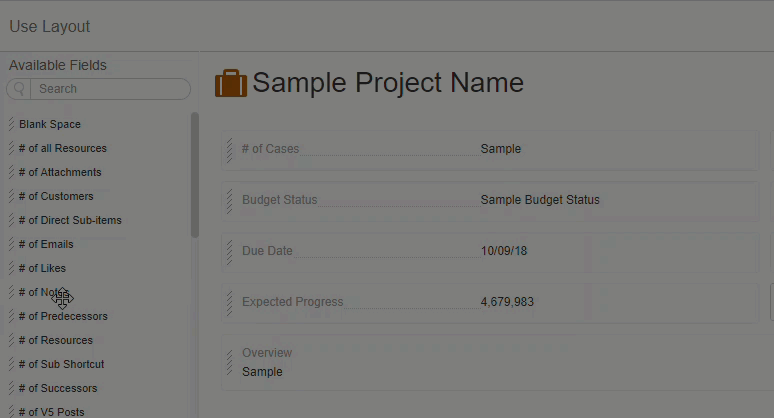Configuring dynamic layouts for the Details view
You can configure the Details view for entities so that the contents that are displayed are based on rules and conditions, rather than the default layout for the user profile For example, you could configure the Details view to display based on the type of project, its department, and its current state. Each work Item or case can have multiple layouts, each with its own set of rules. As conditions change, the layout dynamically updates based on the rules that match the new condition. Learn more about creating layouts
For example, a certain field could be displayed for a project in Draft state, but the same field is not relevant to an active project and therefore is not displayed.
If the rules and conditions do not apply to a user, then layout from the user's profile is displayed.
You can have up to 20 active rules per item type (Project, Task, Request, etc.).
The benefits of using dynamic layouts include the following:
- clutter is reduced since views include only relevant fields
- efficiency is improved because less time is necessary to scroll through long lists, and the need to do searches and for users to switch profiles is reduced
- information is dynamically updated and refreshed the information as projects progress, states change, costs are updated, and so on.
- need for maintenance of profile-level property cards is reduced
To configure a dynamic layout
- Go to Settings > Layouts.
- In the left menu, select the work item or case.
- Click New Layout.

- Enter a Layout name and description.
- Auto Reload: Enables/disables the notification that appears on-screen to users when the layout is dynamically updated. Use this setting to reduce the number of on-screen notifications or when you want to have the screen automatically refresh without prompting users.
- Set Evaluation Criteria.
Add up to 5 rules per layout. You can create basic and advanced rules.
Basic rules
In the Rule field, select the field. Select the operator and Value or Field depending on what the rule field is based on.
Example - This layout is displayed based on the Project State

Example II - This layout is displayed when the person viewing the Project is the Project Manager

Advanced rules- Let you create formulas with OR conditions using ”||”
- Let you access user fields using CurrentUser().Profile to build display rules that use both item fields AND user fields
- Let you use more advanced functions like:
- HasRole
- IsMemberOf
- IsMemberOfProfile
- and more..
Example - This Layout is displayed for a specific Profile (Executive) or for Bob Smith

Note: Rules based on Rich-Text Area fields are not supported.
- If you want additional conditions, click Add rule condition.
Tip: Click the icon to duplicate a rule to create a similar rule. - Use Layout
For each rule, you can define whether to use the Dynamic Layout when the rule applies, or to bypass the rule and use the current Profile layout.
This allows you to design a sophisticated set of rules that let's you use dynamic rules when appropriate together with existing user profile layouts for users who need a simple consistent layout, such as Executive or Customer users.
Directing straight to the user's Current Profile Layout enables you to combine item and user profile data in rules without needing to maintain another set of Layouts.
- Drag fields to and from the sections in the Layout. Move them within the sections as needed.

- To add a new section click Add Section below the existing sections. Add and remove sections as needed.
- Click Save.
- In the Layouts list, enable the new layout.

- Set a Run Order. The Run Order defines which rule is applied. Rules set higher will override those set lower down.

Default Profile Layouts
You can easily access default Profile Layouts from the Layouts page. Default layouts are used when no rules apply.
Click on a default Profile to view and/or edit the default layout. In the Default layout, click Back to list to go back to the Layouts page.

